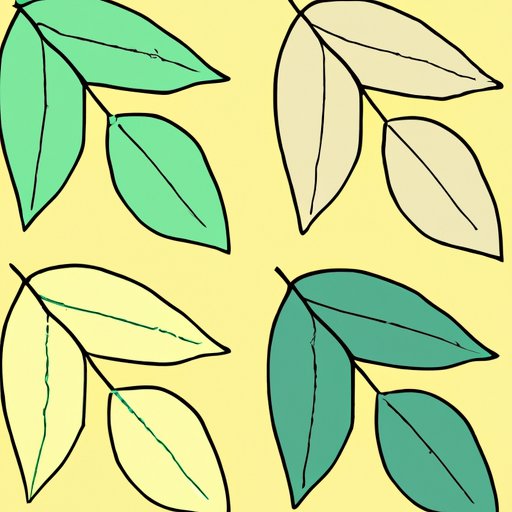Introduction
When it comes to sketching, leaves are a versatile component that finds themselves in countless compositions – from florals to landscapes, and more. Drawing leaves can seem daunting, but with this guide, you’ll have all the necessary tools to sketch them beautifully. In this article, we will explore a step-by-step guide, realistic vs. simplified approaches, different types of leaves, how to draw leaves in nature, tools and medium, and foliage composition.
Step-by-Step Guide
Step-by-step guides are essential building blocks to learn how to draw anything better. Starting with basic shapes such as circles and ovals can be a good way to create leaf forms. Additionally, understanding the angles, contours and veins can help make your leaves look more realistic.
To start, sketch out a basic shape of the leaf based on the type of leaf you want to draw. It’s okay if it doesn’t look like the final product at this point. Then, add the stem. After adding the stem, concentrate on the guidelines going across the leaf to get the angle of the veins. Once you have those, add smaller lines branching from the veins to create a more realistic look.
Realistic vs. Simplified Approaches
The realistic approach is perfect for documenting nature, conveying a sense of realism and accuracy. On the other hand, simplifying the leaf lets you create unique styles, especially for animation, comic book designs, or other graphic artwork. Both techniques are valuable tools to have, and it ultimately depends on the intent of the sketch.
For realistic leaves, focus on the texture and details. Observe the differences between the veins, the proportions and the edge angled compared to backlit leaf. By concentrating, you’ll be able to capture those little details that can make or break your work.
To simplify, start by minimizing the number of veins present. Simplify the edges to create a smoother flow and don’t sweat the smaller details.
Types of Leaves
Different types of leaves have variation in shape, texture, and color. Some popular types include the oak leaf, maple Leaf, and the palm leaf.
To draw an oak leaf, draw two lobes on either side of the stem, drawing a shallow curve to connect them. After that, add the rest of the lobes outward in line from those original lobes, creating five to seven overall.
Maple leaves are identifiable by their rounded tops and V-shaped indentations. Starting with the stem, draw two lobes that give the leaf a basic shape, then concentrate on the serrated edges.
Palm leaves are distinctive with their long blade-like look. Start off with the midrib, going down to the leaf, then add the leaflets, coming out from the midrib. Palm leaves are symmetrical, so replicating the same pattern on another side will add balance.
Drawing Leaves in Nature
Drawing leaves in nature can be a daunting task, but it’s also where you can capture the essence of floral and fauna. The best way to capture nature is to go out and experience it first hand. Sketching outside can be challenging, especially when the weather isn’t cooperating. One option is to take pictures, seeking inspiration from a variety of angles and lighting conditions. Pay attention to how colors change depending on the lighting, how movement affects the leaves, and how it is impacted by contrast.
Tools and Medium
The tools used for creating leaf art with pencils or colored pencils will differ from those used for paints, pens, etc. Drawing pencils come in different weights, which affect the dark parts and light parts of the sketch. A softer pencil gives a darker shade, whereas a lighter pencil is better for lighter shading.
When using colored pencils, use light lines, only building to darker shades once you’re happy with the direction. Layer different colors to create depth within the sketch.
Foliage Composition
The foliage composition is the combination of the leaves and branches. In this aspect, you would want to know the different types of leaves that come with the branches, pairing them together in different ways for desired compositions. Concentrate on the balance and the placement of the leaves and branches to create depth and a three-dimensional look.
Conclusion
Drawing leaves, while it may seem intimidating, is a relatively easy feat once you know the basics. Understanding the different techniques and approaches will broaden opportunities to create beautiful pieces of artwork. Now that you’ve completed the guide, take time to practice using different types of leaves and compositions to develop your skills. With practice, it’s possible to create realistic and intricate leaf artwork.
